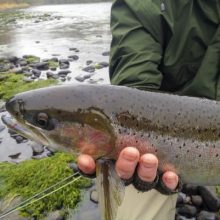This article may contain affiliate links. If you make a purchase after clicking on a link we may earn a small commission at no extra cost to you. As an Amazon Associate, I earn from qualifying purchases.
Best Steelhead Lures

Fishing for steelhead does not need to be a complicated as some anglers make it. Having a few basic steelhead lures in your arsenal is all your really need.
A selection of sizes and colors of the following different types of lures should be enough for practically any light or water conditions you may fish in:
- Spinners
- Spoons
- Jigs
- Artificial worms
Although a lot of people will stick to using natural steelhead bait such as salmon roe, this kind of approach can and does limit your ability to hook a steelhead especially if it a stretch of water you have not fished before.
Best Steelhead Lures
1. Blue Fox Vibrax
If spinning from the bank is your game then you can’t go wrong with an old reliable like the Blue Fox Vibrax.
2. Acme Kastmaster
Kastmaster lure work great when fishing larger rivers as they are pretty heavy for their size. The classic colors such as gold, silver or the blue and chrome will work best.
3. Nightmare Jig
The nightmare jig is easily the best known jig for steelhead fishing. Although it does look rather odd it can be an absolute killer when worked under a float.
4. Artificial Worms
Plastic worms fished under a float or drifted along the bottom are another popular option. There are a lot of different colors available however I have always found pink to be one of the most successful.
5. Luhr Jensen Kwikfish
If you are trolling the the Lure Jensen Kwikfish or Flatfish lures can force a large steelhead into striking. They have a very distinctive wobble and give out a lot of vibration when trolled.
The best lures for steelhead will have some sort of wobble action or give off a vibration, that combined with some kind of flash like a gold or silver blade is what will force a steelhead to strike especially if you can get it right in front of their nose.
How to Fish Steelhead Lures
Steelhead lure selection need not be that complicated. Before you tie on a lure it is important to think about what kind of water you are fishing and just where exactly will the steelhead be lying.
There are a number of important factors to consider before you select a lure:
- Time of year
- Light and weather conditions
- Depth of the water you are fishing
Fishing steelhead lures can fall into two main approaches. Fishing more active lures on the retrieve like spinners/spoons and bait imitators like jigs/worms.
Both types of lures rely on you working them across the river and being able to judge how deep the lure is fishing. Ideally you will want to have the lure bounce the bottom a few times.
Casting is generally done in a large fan like pattern, across and upstream from you. Using a large fan like pattern allows you to cover as much of the river as possible.
Always be on the look out for signs of small pockets or holes in the river bed as this is where steelhead have a particular liking for. They will happily move through main runs and tailouts so be sure to work these extensively, in fact these should be your first focus on your initial casts.
Spinners/Spoons
Fishing any lure for steelhead that requires a retrieve to activate it’s action or wobble is probably the most effective way to force a strike from a large steelhead.
The name of the game here is to work the lure slowly. Cast across the water and slightly upstream in front of you, allow the lure to sink so that it may hit the bottom. Then start a slow retrieve.
The retrieval rate should be just enough to keep the lure from hitting or snagging on the bottom. Steelhead will very rarely if ever take a lure that is several feet higher than them in the water column.
You will need to practice this and get a feel for the weight of the lure you are fishing , how deep the water is and how strong the current is running. All of these things will effect your ability to work the lure slowly in front of the fish.
Jigs/Worms
Jigs and worms will generally require the use of added weight or a bobber to get the best distance possible.
You can bottom bounce or drift fish your way down the river when using nymphs and worms. Again just like retrieving a lure you’ll need to work the nymph/worm through the runs and tailouts.
One of the best skills you can develop is learning to distinguish between a strike and you weight bouncing or snagging in the bottom. This unfortunately takes time and experience.
The more natural the presentation the better. You are trying to imitate a nymph or sub-aquatic insect moving down river at the mercy of the current. Letting them drift naturally without any interference from your rod tip or line is key.
